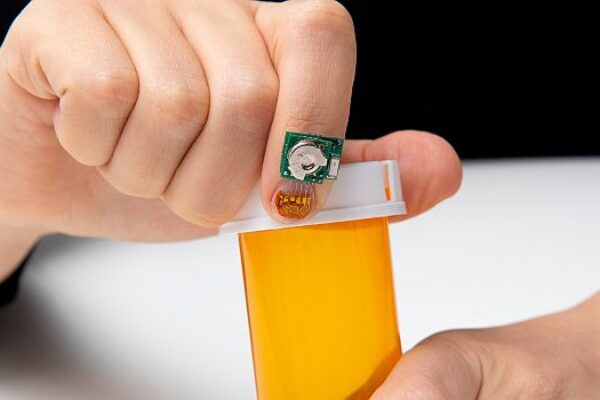
Fingernail sensor monitors diseases, movement disorders
The wearable, wireless device project began, say the researchers, as an attempt to capture the medication state of people with Parkinson’s disease. While skin-based sensors can be used to measure disease progression – by capturing motion, the health of muscles and nerve cells, or changes in sweat gland activity – they can often cause problems with older patients, including infection.
“This is where the potential of a fingernail sensor comes into play,” say the researchers. “We interact with objects throughout the day using our hands, such as the tactile sensing of pressure, temperature, surface textures, and more. Our team realized it might be possible to derive interesting signals from how the fingernail bends throughout the course of a day, as we use our fingers to interact with our environment, and tap into the power of AI and machine learning to analyze and derive valuable insights from that data.”
Fingernails deform – bend and move — in stereotypic ways when used for such activities as gripping, grasping, and even flexing and extending fingers. While the deformation is usually on the order of single digit microns (or micrometers) and not visible to the naked eye, it can easily be detected and measured with strain gauge sensors.
By gluing a sensor system to a fingernail, the researchers found with dynamometer experiments that they could extract a consistent enough signal from the nail to give good grip force prediction in a variety of grip types. In addition, they say, they found it is possible to deconvolve subtle finger movements from nail deformation.
They were able to differentiate typical daily activities, such as turning a key, opening a doorknob, or using a screwdriver, as well as even more subtle activities such as finger writing. In the latter case, they trained a neural network to produce a very good accuracy (.94) at detecting digits written by a finger wearing the sensor.
The researchers’ system consists of strain gauges attached to the fingernail and a small computer that samples strain values, collects accelerometer data, and communicates with a smart watch. The watch also runs machine learning models to rate bradykinesia, tremor, and dyskinesia, which are all symptoms of Parkinson’s disease.
Looking ahead, the researchers plan to focus on shrinking the electronics of the device by using wafer-level chip scale packaging, switching to a flexible substrate, and reducing power by changing to micrometer scale. In addition, they say, replacing the large metal foil strain gauge package with tiny silicon strain gauges will allow the nail to move more freely.
Packaging and installation present many challenges, as the system should ultimately be waterproof and easy to install and remove. Finally, identifying and quantifying injury producing motions for immediate feedback to the wearer is also a goal.
For more, see “Wearable Nail Deformation Sensing for Behavioral and Biomechanical Monitoring and Human-Computer Interaction.
IBM
Related articles:
Fingernail UV sensor is ‘world’s smallest’ wearable
Tooth-mounted sensor can track dietary intake
Wearable skin-like sensor maps blood-oxygen levels anywhere
Wearable biosensor measures ‘stress hormone’ in sweat
 If you enjoyed this article, you will like the following ones: don't miss them by subscribing to :
eeNews on Google News
If you enjoyed this article, you will like the following ones: don't miss them by subscribing to :
eeNews on Google News




